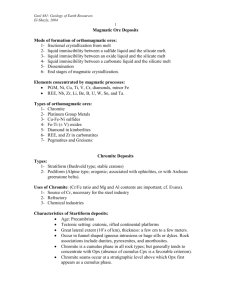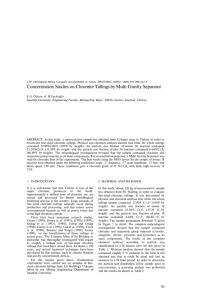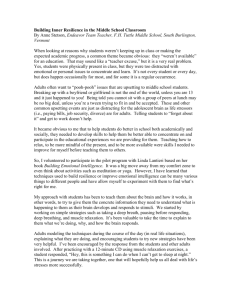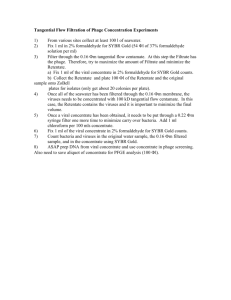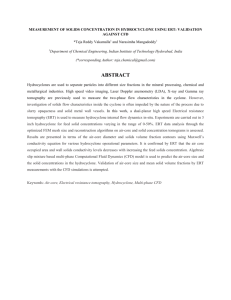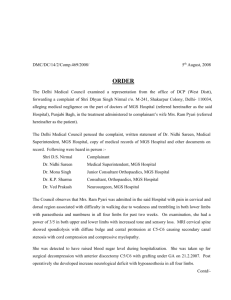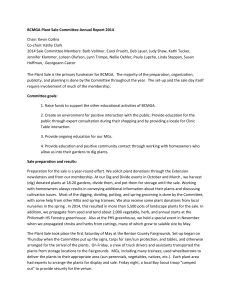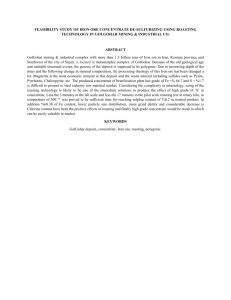Modelling and optimization of clean chromite production from fine
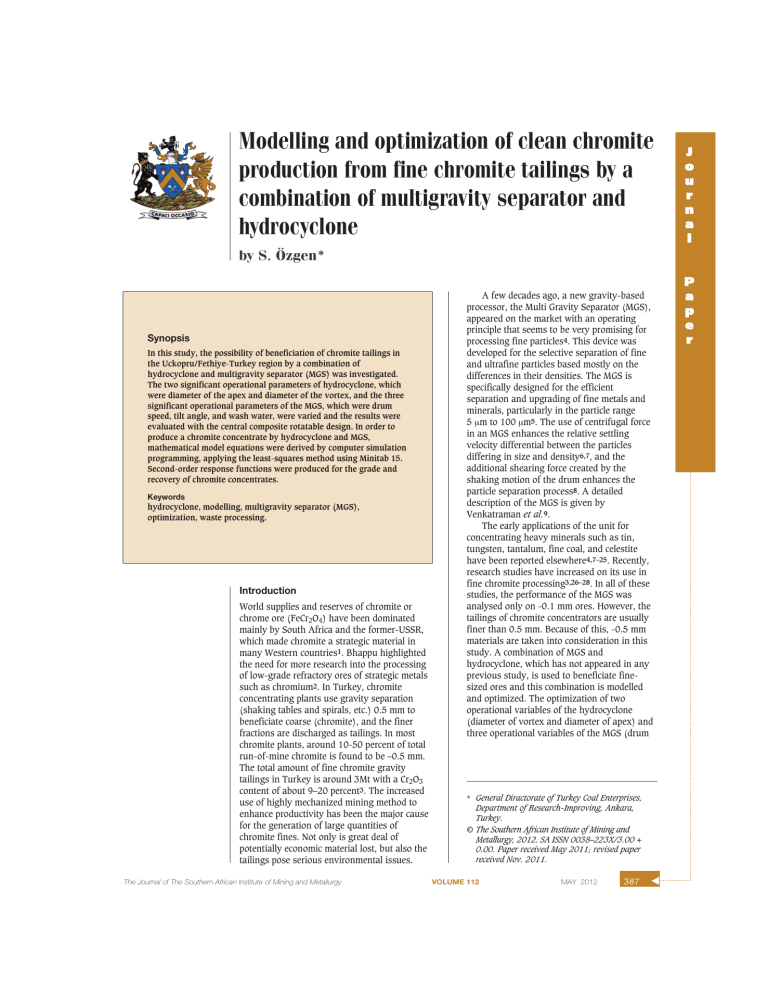
Modelling and optimization of clean chromite production from fine chromite tailings by a combination of multigravity separator and hydrocyclone by S. Özgen*
r n a l
J o u
P a p e r
Synopsis
In this study, the possibility of beneficiation of chromite tailings in the Uckopru/Fethiye-Turkey region by a combination of hydrocyclone and multigravity separator (MGS) was investigated.
The two significant operational parameters of hydrocyclone, which were diameter of the apex and diameter of the vortex, and the three significant operational parameters of the MGS, which were drum speed, tilt angle, and wash water, were varied and the results were evaluated with the central composite rotatable design. In order to produce a chromite concentrate by hydrocyclone and MGS, mathematical model equations were derived by computer simulation programming, applying the least-squares method using Minitab 15.
Second-order response functions were produced for the grade and recovery of chromite concentrates.
Keywords hydrocyclone, modelling, multigravity separator (MGS), optimization, waste processing.
Introduction
World supplies and reserves of chromite or chrome ore (FeCr
2
O
4
) have been dominated mainly by South Africa and the former-USSR, which made chromite a strategic material in many Western countries 1 . Bhappu highlighted the need for more research into the processing of low-grade refractory ores of strategic metals such as chromium 2 . In Turkey, chromite concentrating plants use gravity separation
(shaking tables and spirals, etc.) 0.5 mm to beneficiate coarse (chromite), and the finer fractions are discharged as tailings. In most chromite plants, around 10-50 percent of total run-of-mine chromite is found to be –0.5 mm.
The total amount of fine chromite gravity tailings in Turkey is around 3Mt with a Cr
2
O
3 content of about 9–20 percent 3 . The increased use of highly mechanized mining method to enhance productivity has been the major cause for the generation of large quantities of chromite fines. Not only is great deal of potentially economic material lost, but also the tailings pose serious environmental issues.
The Journal of The Southern African Institute of Mining and Metallurgy
A few decades ago, a new gravity-based processor, the Multi Gravity Separator (MGS), appeared on the market with an operating principle that seems to be very promising for processing fine particles 4 . This device was developed for the selective separation of fine and ultrafine particles based mostly on the differences in their densities. The MGS is specifically designed for the efficient separation and upgrading of fine metals and minerals, particularly in the particle range
5 μ m to 100 μ m 5 . The use of centrifugal force in an MGS enhances the relative settling velocity differential between the particles differing in size and density 6,7 , and the additional shearing force created by the shaking motion of the drum enhances the particle separation process 8 . A detailed description of the MGS is given by
Venkatraman et al.
9 .
The early applications of the unit for concentrating heavy minerals such as tin, tungsten, tantalum, fine coal, and celestite have been reported elsewhere 4,7–25 . Recently, research studies have increased on its use in fine chromite processing 3,26–28 . In all of these studies, the performance of the MGS was analysed only on -0.1 mm ores. However, the tailings of chromite concentrators are usually finer than 0.5 mm. Because of this, -0.5 mm materials are taken into consideration in this study. A combination of MGS and hydrocyclone, which has not appeared in any previous study, is used to beneficiate finesized ores and this combination is modelled and optimized. The optimization of two operational variables of the hydrocyclone
(diameter of vortex and diameter of apex) and three operational variables of the MGS (drum
* General Diractorate of Turkey Coal Enterprises,
Department of Research-Improving, Ankara,
Turkey.
© The Southern African Institute of Mining and
Metallurgy, 2012. SA ISSN 0038–223X/3.00 +
0.00. Paper received May 2011; revised paper received Nov. 2011.
VOLUME 112 MAY 2012 387
Modelling and optimization of clean chromite production from fine chromite tailings speed, tilt angle, and wash water flow rate) have been considered. Moreover, the use of central composite rotatable design (CCRD) and response surface methodology, already successfully applied in other fields, is well suited to the study of the effects of the variables on chromite concentration using the hydrocyclone and MGS.
In the following sections, the requirements for CCRD with response surface method and their applications to the design of experiments and modelling of the hydrocyclone and MGS are described for chromite concentration. Additionally, the operational variables for hydrocyclone and MGS for maximum grade and recovery of chromite concentrate we optimized using quadratic programming in the mathematical software package Minitab 15 29 .
Materials and methods
Materials
The chromite tailings samples used in this study were obtained from the concentrator plant of Uckopru (Fethiye-
Turkey). Samples taken from the waste dam were screened at
0.5 mm. Table I presents the Cr
2
O
3 analysis of the chromite tailing samples with respect to particle size. The –0.5 mm sample containing 14.79 percent Cr
2
O
3
. Table I show that the content of the sample increased with a decrease in particle size. Maximum Cr
2
O
3 fraction. grades reported to the –0.038 mm
Experimental equipment
Hydrocyclone
Mineral processes use hydrocyclone separators to perform separations on the basis of size and/or density differences between the dispersed particulate phases 30,31 . Hydrocyclones consist of two main parts. There is a cylindrical part, with an inlet through which the feed enters tangentially. The outlet, is located vertically on top of the cylinder, that extends within the cylinder and is called the vortex finder. The second main part is a conical part between the cylindrical section on the top and the underflow spigot at the bottom. The centrifugation forces exerted by the vortex carry larger particles to the cyclone wall; these are discharged via an underflow orifice (spigot). Small particles are moved to the central axis of the cyclone and carried out by the overflow stream 32,33 .
Table I
Analysis of chromite tailings
Particle size μm Weight %
-500+425
-425+300
-300+212
-212+106
-106+75
-75+53
-53+38
-38
Total
4.77
5.08
4.70
7.19
6.59
8.44
9.98
53.25
100
388
Grade (Cr
2
O
3
) %
4.75
5.24
4.98
5.12
6.38
10.14
12.12
21.05
14.79
MAY 2012 VOLUME 112
Multi gravity separator (MGS)
The operating principle of the MGS is similar to that of a conventional shaking table, except that centrifugal forces are used to enhance the separation of fine particles. The laboratory/pilot plant scale C-900 MGS consists of a slightly tapered open-ended drum 600 mm long with a diameter of
500 mm that rotates in a clockwise direction and is shaken sinusoidally in an axial direction. In this system, feed slurry is distributed along the inner surface of a slightly tapered rotating drum. Light particles are carried by the flowing film to the far end of the drum, while heavy particles pinned against the wall by the centrifugal field are carried by rotating scrapers to the opposite end of the drum. A small amount of wash water is added to the heavies discharge end of the drum to wash out entrained low-density particles. Successful applications of the MGS technology include the concentration of cassiterite, chromite, wolfamite, graphite, mixed sulfides, and gold. In addition, testing of a pilot-scale MGS unit was recently completed at the Pittsburgh Energy Technology
Center (PETC) for applications involving the desulfurization of fine coal. The results of this work showed that the pyritic sulfur rejection obtained by the MGS was nearly twice that achieved using conventional fine-particle processing techniques. Since the unit operates under a low centrifugal field (<25 g ), its throughput capacity is very low compared to the other enhanced gravity separators 34 . The parameters affecting the efficiency of separation on the MGS are the drum speed (continuously variable from 100 to 300 r/mim), tilt angle (0° to 9°), shake amplitude (10/15/20 mm), shake frequency (4.0/4.8/5.7 cycles per second), wash water flow rate (0 to 10 l/min), and pulp density of the feed slurry (10 percent to 50 percent by mass) 25,28 .
Experimental design
Experimental design methods and response surface methodologies (RSMs) are widely used for modelling process parameters, particularly in chemical processes and pharmaHowever, they have not been widely applied to mineral processing systems. The central composite design has been successfully used to design an experimental programme to provide data to model the effects of inlet pressure, feed density, and length and diameter of the inner vortex finder on the operational performance of a 150 mm three-product cyclone 35 . A study on flotation tests of synthetic mixtures of celestite (SrSO
4
) and calcite (CaCO
3
) using a factorial experimental design has been discussed by
Martinez et al.
36 . Finally, Aslan 25 developed a three-level
Box-Behnken factorial design combined with response surface methodology for modelling and optimizing of some operations parameter of the MGS to produce a celestite concentrate.
RSM is a collection of statistical and mathematical methods that involves experimental designs to achieve adequate and reliable measurement of the response of interest. The response surface can be expressed as
[1] where y is the response and xi ’s are the operating variables of the process. An important assumption is that the operating variables are continuous and controllable with negligible errors.
The Journal of The Southern African Institute of Mining and Metallurgy
Modelling and optimization of clean chromite production from fine chromite tailings
Among different RSM experimental designs, CCRD has been widely used because it requires fewer experimental runs and provides sufficient information compared to a factorial design. The number of tests required for the CCRD includes the standard 2 k factorial with its origin at the centre, 2 k points fixed axially at a distance, say b , from the centre to generate the quadratic terms, and replicate tests at the centre; where k is the number of variables. The axial points are chosen such that they allow rotatability 37 , which ensures that the variance of the model prediction is constant at all points equidistant from the design centre. Replicates of the test at the centre are very important as they provide an independent estimate of the experimental error. For five variables, the recommended number of tests at the centre is six 37 . Hence the total number of tests required for the four independent variables is
25
2
+ (2 x 5)+6 = 32, which is at least, 32 experiments less than that required for a half factorial design.
Once the desired ranges of values of the variables are defined, they are coded to lie at ±1 for the factorial points, 0 for the centre points, and ± β for the axial points. The codes are calculated as functions of the range of interest of each factor as shown in Table II. When the response data is obtained from the test work, a regression analysis is carried out to determine the coefficients of the response model (a
1
, a
2
,…, a n
), their standard errors, and significance. In addition to the constant (a
0
) and error ( ε ) terms, the response model incorporates:
® Linear terms in each of the variables ( x
® Squared terms in each of the variables (
1 x
, x
12
2
® First order interaction terms for each paired
,
, . . ., x
22 x n
,…,
) x n
2
) combination ( x
1 x
2, x
1 x
3
, . . ., x n -1 x n
).
Thus for the four variables under consideration, the response model is:
[2]
® For the MGS, drum speed of 105–245 r/min, tilt angle of 0˚–8˚, wash water of 1–9 l/min.
Applying the relationships in Table II, the values of the codes were calculated as shown in Table III. These were then used to determine the actual levels of the variables for each of the 32 experiments (Table IV).
Considering the effects of main factors and also the interactions between two factors, Equation [2] takes the form:
[3]
Table III
Values of codes in the CCRD
Variable
Diameter of apex,
( a ), mm
Diameter of vortex
( v ), mm
Drum speed (d), r/min
Tilt angle ( t ), º
Wash water ( w ), l/min
Symbol
-
β x
1
Coded variable level
Lowest Low Center High Highest
-1 0 +1 +
β
1.6
3.2
4.8
6.4
8.0
x x x x
2
3
4
5
5.0
105
0
1
8.0
140
2
3
11
175
4
5
14
210
6
7
17
245
8
9
The β coefficients are obtained by least-squares methods.
The coefficients, i.e. the main effect ( β i
) and two-factors interactions ( β ij
), can be estimated from the experimental results by computer simulation programming applying the least-squares method using ‘Minitab 15’.
CCRD was used to design the experiments to the requirements mentioned above. In order to obtain the required data, the range of values of each of five variables was defined as follows:
® For the hydrocyclone, diameter of vortex of 5.0–17.0
mm, diameter of apex of 1.6–8.0 mm
-
β
-1
0
+1
+
β
Table II
Codes and variables used in the CCRD
Code Actual value of variable x min
[(x max
+x min
)/2]-[(x max
-x min
)/2
α
]
[(x max
+x min
)/2]
[(x max
+x min
)/2]+[(x max
-x min
)/2
α
] x max
X max and x min
=maximum and minimum values of x respectively;
α
=2
(k-1)/4
; k=number of variables (in this study;
α
=2 4/4 =2)
The Journal of The Southern African Institute of Mining and Metallurgy
Table IV
Levels of variables for hte experimental runs
Run x
1
10
11
12
13
14
15
16
17
18
19
3
4
5
1
2
8
9
6
7
20
21
22
23
24
25
26
27
28
29
30
31
32
-1
-1
-1
-1
-1
-1
-1
0
0
0
+1
+1
+1
+1
+1
+1
+1
+1
-1
+
-
0
0
0
0
0
0
0
0
0
0
0
Coded level of variables x
2 x
3 x
4 x
5
+1
+1
+1
-1
-1
-1
-1
0
0
0
+1
+1
+1
+1
-1
-1
-1
-1
+1
0
0
-
0
0
0
+
0
0
0
0
0
0
+1
-1
-1
+1
+1
-1
-1
0
0
0
+1
+1
-1
-1
+1
+1
-1
-1
+1
0
0
0
0
0
0
-
0
+
0
0
0
0
-1
+1
-1
+1
-1
+1
-1
0
0
0
+1
-1
+1
-1
+1
-1
+1
-1
+1
0
0
0
0
0
0
0
-
0
0
+
0
0
+1
+1
-1
+1
-1
-1
+1
0
0
0
+1
-1
-1
+1
-1
+1
+1
-1
-1
0
0
0
0
0
0
0
0
0
0
0
-
+ a
Actual level of variables v d t w
3.2
3.2
3.2
3.2
3.2
3.2
3.2
4.8
4.8
4.8
6.4
6.4
6.4
6.4
6.4
6.4
6.4
6.4
3.2
4.8
4.8
4.8
1.6
8.0
4.8
4.8
4.8
4.8
4.8
4.8
4.8
4.8
8
8
8
14
14
14
8
11
11
11
14
14
14
14
8
8
8
8
14
11
11
11
11
11
5
17
11
11
11
11
11
11
210
140
140
210
210
140
140
175
175
175
210
210
140
140
210
210
140
140
210
175
175
175
175
175
175
175
105
245
175
175
175
175
6
2
6
2
6
2
4
4
2
4
6
2
6
6
2
2
6
2
6
4
4
4
4
4
4
4
0
4
4
8
4
4
7
3
3
7
7
3
5
5
7
5
3
7
3
7
3
3
3
7
7
5
5
5
5
5
5
5
5
5
5
5
1
9
VOLUME 112 MAY 2012 389
P a p e r
J o u r n a l
Modelling and optimization of clean chromite production from fine chromite tailings where x
β
2
5
,
β
35
β4
4 x
3
, x y
4 is the predicted response,
, and and β
45 and β
55 x
4 are linear coefficients; β
12
, β
13
β
0 the model constant; are independent variables;
, β
14
, β
15
β
1
, β are cross-product coefficients, and β
11
, β2
2 are the quadratic coefficients
, β
23
, β
2
24
24,25,38–41
, β
3
, β
.
, β
4
,
, and
β3 x
3
1
25
, β3
4
,
,
,
Experimental procedure
In this study, the CCRD was chosen to study the relationship between the response functions (chromite grade and recovery of the chromite concentrate) and two variables of the hydrocyclone (diameter of vortex, and diameter of apex) and three variable of the MGS (drum speed, tilt angle, and wash water flow rate). The other operational parameters of the hydrocyclone (cyclone diameter of 44 mm, solid ratio of 10 percent, feed suspension of 30 L, pre-feed mixture of 5 minutes, and inlet pressure of 1 bar) and MGS (15 mm of shaking amplitude and 4.8 cycle per second frequency) were kept constant. The hydrocyclone and MGS variables were adjusted at the required levels as per the CCRD. The batch hydrocyclone and MGS tests were conducted in our mineral processing laboratories using the experimental setup shown in Figure 1.
Samples were dried at 100°C. In each test, 3000 g of the dry chromite ore was used. The dried samples were added to water (10 percent solid ratio) and were stirred for 5 minute by a propeller agitator. The suspension was passed through a
500 mm sieve and to the sieved suspension was fed hydrocyclone. The suspension was stirred with a peristaltic pump and by-pass valve for 5 minutes to achieve homogeneity. Later, material was fed to the hydrocyclone by closing the by-pass valve, and two discrete overflow and underflow products were obtained. The overflow was fed directly to the MGS. The diameter of apex, diameter of vortex, drum speed, tilt angle, and wash water flow rate were changed during these tests as per the levels in the design matrix in Table IV, while the other parameters of the hydrocyclone and MGS were kept constant.
Samples from the chromite concentrate, coarse tailing streams, and fine tailing streams were collected at steadystate conditions. The samples were filtered, dried, weighed, and analysed for grade and recovery. For each sample, 0.5 g was analysed by a titrimetric method 42 .
Results and discussion
Model development
From the experimental results in Table V and Equation [3], the second-order response functions representing chromite concentrate grade and recovery can be expressed as a function of the two operating parameters of the hydrocyclone and three operating parameters of the MGS, namely the diameter of apex ( a ), diameter of vortex ( v ), drum speed ( d ), tilt angle ( t ), and wash water ( w ).
The equation relating the hydrocyclone and MGS variables and the concentrate chrome grade was as follows:
The equation relating the hydrocyclone variables, MGS variables, and the concentrate chrome recovery was as follows:
[4]
[5]
The actual and predicted values of both the concentrate grade and recovery obtained using model Equations [4] and
[5] are presented in Figures 2 and 3 respectively. The respective correlation coefficient (R
2
) values of 90.05 percent and 95.62 percent establish the validity of the proposed equations within the range of the variables studied.
Peristatic
Pump
Pressure
Gauge
Overflow
CYCLONE
Feed for MGS
Mixer
Underflow
Sump of underflow product
Coarse
Tailing
Concentrate
MGS
Fine
Tailing
Figure 1—Hydrocyclone and MGS combination experimental setup
390 MAY 2012 VOLUME 112
Effect of MGS variables and diameter of apex on concentrate grade and recovery
For better understanding of the results, the predicted models were described in three-dimensional (3D) response surface plots (Figure 4). The diagrams show the 3D response surface plots relationship between variables of the MGS, apex diameter of the hydrocyclone, and chrome content of the concentrate or chrome recovery to the concentrate at the centre level of the other three variables.
In Figure 4, a, cs and e, the chrome content of concentrate is shown, which is affected by the diameter of the apex. The chrome content of the concentrate changed by between 1–2 percent by variation of diameter of apex. The chrome content of the concentrate decreases when the diameter of the apex is decreased. Because of this, heavy and coarse products were obtained from underflow of hydrocyclone. So, coarse and heavy products tend to vortex-out, that to say overflow when diameter of apex is reduced. For this reason, polluted products were input to the MG; however, the chrome content decreases. The final concentrate grade obtained is reduced because the chrome content of the feed to the MGS is also lower. Figures 4 b, ds and f, show that the recovery of
The Journal of The Southern African Institute of Mining and Metallurgy
Modelling and optimization of clean chromite production from fine chromite tailings
Table V
Results of the batch tests
Run Product
17 Concentrate
Tailing
18 Concentrate
Tailing
19 Concentrate
Tailing
20 Concentrate
Tailing
21 Concentrate
Tailing
22 Concentrate
Tailing
23 Concentrate
Tailing
24 Concentrate
Tailing
25 Concentrate
Tailing
26 Concentrate
Tailing
27 Concentrate
Tailing
28 Concentrate
Tailing
29 Concentrate
Tailing
30 Concentrate
Tailing
31 Concentrate
Tailing
32 Concentrate
Tailing
FEED
1
2
3
4
5
6
7
8
9 Concentrate
Tailing
10 Concentrate
Tailing
11 Concentrate
Tailing
12 Concentrate
Tailing
13 Concentrate
Tailing
14 Concentrate
Tailing
15 Concentrate
Tailing
16 Concentrate
Tailing
Concentrate
Tailing
Concentrate
Tailing
Concentrate
Tailing
Concentrate
Tailing
Concentrate
Tailing
Concentrate
Tailing
Concentrate
Tailing
Concentrate
Tailing
Mass. % Grade, Cr
2
O
3
% Recovery, Cr
2
O
3
%
Observes Predicted Observes Predicted
(R
2
90.05%) (R
2
95.62%)
34.02
65.98
31.83
68.17
24.05
75.95
30.44
69.56
33.10
66.90
29.72
70.28
28.60
71.40
29.72
70.28
100
34.51
65.49
32.65
67.35
31.49
68.51
22.63
77.37
29.48
70.52
26.86
73.14
29.72
70.28
29.72
70.28
29.72
70.28
31.60
68.40
21.84
78.16
23.61
76.39
35.62
64.38
24.54
75.46
26.79
73.21
29.72
70.28
29.72
70.28
37.17
62.83
29.81
70.19
29.18
70.82
26.51
73.49
21.42
78.58
27.86
72.14
28.41
71.59
34.14
4.81
35.98
4.89
42.44
6.04
36.85
5.14
35.35
4.62
38.15
4.91
38.96
5.11
38.15
4.91
14.79
33.76
4.79
35.01
4.99
36.15
4.97
45.17
5.90
38.06
5.06
40.24
5.44
38.33
4.83
38.15
4.91
38.15
4.91
36.36
4.82
45.96
6.08
43.87
5.80
33.15
4.63
42.86
5.66
40.41
5.41
38.15
4.91
38.15
4.91
32.21
4.49
37.17
5.28
38.63
4.97
40.12
5.65
48.18
5.69
39.22
5.35
38.86
5.24
34.30
4.73
33.64
5.99
41.71
6.27
36.23
5.41
37.84
3.38
38.30
4.85
39.10
5.05
38.30
4.85
14.79
35.23
4.02
36.10
4.46
36.46
4.83
45.62
5.77
37.02
5.50
40.47
5.36
38.26
4.86
38.30
4.85
38.30
4.85
35.41
5.26
44.90
6.37
44.70
5.55
32.86
4.79
41.93
5.96
41.86
4.88
38.30
4.85
38.30
4.85
32.13
4.53
36.90
5.40
37.30
5.52
41.60
5.12
44.80
6.61
40.91
4.70
39.29
5.07
78.52
21.48
77.44
22.56
69
31
75.84
24.16
79.12
20.88
76.65
23.35
75.35
24.65
76.65
23.35
100
78.78
21.22
77.28
22.72
76.98
23.02
69.11
30.89
75.86
24.14
73.09
26.91
77.03
22.97
76.65
23.35
76.65
23.35
77.69
22.31
67.88
32.12
70.02
29.98
79.84
20.16
71.12
28.88
73.21
26.79
76.65
23.35
76.65
23.35
80.94
19.06
74.92
25.08
76.21
23.79
71.92
28.08
69.79
30.21
73.89
26.11
74.65
25.35
78.54
21.46
79.29
20.71
69.41
30.59
75.93
24.07
77.97
22.03
76.56
23.44
75.27
24.73
76.56
23.44
100
77.91
22.09
76.49
23.51
76.7
23.3
68.98
31.02
76.5
23.5
73.19
26.81
76.83
23.17
76.56
23.44
76.56
23.44
78.33
21.67
68.43
31.57
69.81
30.19
79.87
20.13
71.8
28.2
71.92
28.08
76.56
23.44
76.56
23.44
80.69
19.31
75.4
24.6
76.93
23.07
71.1
28.9
71.51
28.49
72.79
27.21
74.47
25.53
The Journal of The Southern African Institute of Mining and Metallurgy
Figure 2—Relationship between experimental and predicted grade of the chromite concentrations using Equation [4]
Figure 3—Relationship between experimental and predicted recovery of the chromite concentrations using Equation [5]
Figure 4—Response surface plots showing the effect of drum speed
(a-b), the effect of tilt angle (c-d), the effect of wash water (e-f), with diameter of apex of hydrocyclone on the grade and recovery of chromite concentrate
VOLUME 112 MAY 2012 391 n a l
J o u r
P a p e r
Modelling and optimization of clean chromite production from fine chromite tailings concentrate is affected by the diameter of the apex but only by between 1–2 percent. Figures 4 a–b, show that when the drum speed was decreased, the chrome content of the concentrate increased but recovery of concentrate decreased.
When drum speed was increased, centrifugal force also increased, and therefore the mass reporting to concentrate also increases as more high-density material is recovered.
This decreases the chrome content of the concentrate, but increases recovery of concentrate. Lower velocity should therefore, and higher velocity for higher recovery.
In Figures 4 c–d show that when tilt angle was decreased, chrome content of the concentrate decreased but recovery of concentrate was increased. This effect may be explained by the fact that with an increase in tilt angle, the downward flow velocity of the wash water increases. As a result, the residence time of the particles inside the drum decreases, which eventually decreases the separation time between the heavies and lights inside the drum. Because of this, when the wash water flow rate was increased, the chrome content of the concentrate increased but recovery of concentrate decreased. A higher tilt angle should be selected for a higher chrome content of concentrate, and a lower tilt angle for higher recovery.
When the wash water flow rate was decreased, the chrome content of the concentrate decreasd, but recovery of concentrate was increased Figure 4 e–f. This is similar to the effect observed by changing the tilt angle. This may be explained by the fact that with an increase in wash water flow rate, the water velocity increases. As a result, more feed material is transported toward the underflow, which ultimately increases the chrome grade of the concentrate and decreases the chrome recovery to the concentrate. A higher wash water flowrate should be selected for higher chrome content of concentrate, and a lower flow rate for higher recovery.
Figure 5—Response surface plots showing the effect of drum speed
(a-b), the effect of tilt angle (c-d), the effect of wash water (e-f), with diameter of vortex of hydrocyclone on the grade and recovery of chromite concentrate
Effect of MGS variables and vortex diameter on concentrate grade and recovery
Figure 5 (a–f) shows the 3D response surface plots relationship between variables ofthe MGS, vortex diameter of hydrocyclone, and chrome content of the concentrate or chrome recovery to the concentrate at the centre level of the other three variables.
In Figure 5 (a, c and e), the diameter of vortex is shown clearly to affect the chrome content of the concentrate. As seen, changing the diameter of the vortex resulted in only small variations in product quality. In Figure 5 (b, d, and f), the vortex diameter of is shown to affect the recovery of concentrate by up to 1 percent. Fine and light products were obtained from hydrocyclone overflow. Because of this, when the diameter of the vortex is decreased, fine and light product reports preferentially the underflow, that is to say the apexout. Accordingly, the chrome content decreased, as it escapes from hydrocyclone underflow and recovery of final product is decreased.
In Figure 5 (a–f), the drum speed, the variation of tilt angle, and wash water flow rate are examined. The results show the same behavior as that obtained by varying the diameter of the apex.
392 MAY 2012 VOLUME 112
Optimization of variables of hydrocyclone and MGS on response
One of the main aims of this study was to maximize the chrome grade and recoveries of chrome concentrates in the process and find the optimum operating conditions from the mathematical models developed. The optimum operational variables of the hydrocyclone and MGS for maximum grade and recovery of the chrome concentrates were calculated using quadratic programming of the mathematical software package Minitab 15 29 . The optimum variables are shown in
Table VI.
Additional independent tests were conducted to confirm the model predictions – thse results are also shown in
Table VI.
Conclusion remarks
In this study, a three-level and central composite rotatable design with a response surface methodology was employed for modelling and optimizing five operations parameters of a combination of a hydrocyclone and MGS to produce chromite concentrate from fine chromite tailings.
The five variables of the model investigated in this study were diameter of apex (mm) and diameter of vortex (mm) of the hydrocyclone, drum speed (r/min), tilt angle (º), and wash water (l/min). The mathematical model equations were derived for both grade and recovery of chromite concentrates by using sets of experimental data and the mathematical software package Minitab 15 29 .
The Journal of The Southern African Institute of Mining and Metallurgy
Modelling and optimization of clean chromite production from fine chromite tailings
Table VI
Optimization
Maximum grade
Maximum recovery
(mm) (mm)
Optimized operational variables of the hydrocyclone and MGS
Diameter of Diameter of Drum speed Tilt Angle Wash water Maximum predicted values Maximum observed values apex vortex (r/min) (º) (lpm) Chrome Chrome Chrome Chrome grade
(%) concentrate recovery (%) grade
(%) concentrate recovery (%)
4.8
3.2
11
14
140
210
6
2
7
3
45.76
31.35
69.24
81.38
43.75
30.52
72.12
80.25
Table VII
Analysis of test 2, with 80.94 percent recovery
Particle size μm Weight % Grade (Cr
2
O
3
) %
-106+75
-75+53
-53+38
-38
Total
0.5
5.12
19.88
74.50
100
35.38
42.14
46.12
49.23
48.18
The predicted values match the experimental values reasonably well, with R
2 of 90.05 percent for grade and R
2 of
95.62 percent for recovery of chromite concentrates. As a result of the experimental studies, the grade of chromite has increased substantially through beneficiation with a hydrocyclone and MGS combination. The greatest grade increase was 225 percent (48.18 percent Cr
2
O
3 to 14.79
percent Cr
2
O
3
). The highest chromite recovery obtained was
80.94 percent (Table VII).
By means of quadratic programming, a diameter of apex of 4.8 mm, diameter of vortex of 11 mm, drum speed of 140 r/min, tilt angle of 6º, and wash water flow rate of
7 l/min have been determined as optimum levels to achieve the maximum concentrate grade of 45.76 percent Cr
2
O
3
. In the same way, a diameter of apex of 3.2 mm, diameter of vortex of 14 mm, drum speed of 210 r/min, tilt angle of 2º, and wash water flow rate of 3 l/min have been determined as optimum levels to achieve the recovery of 81.38%.
This study demonstrates that the CCRD and response surface methodology could be successfully used for modelling the same operating parameters of hydrocyclone and MGS combination for chromite concentrator plant of Uckopru.
CCRD is an economical way of obtaining the maximum amount of information in a short period of time and with the fewest number of experiments. The hydrocyclone and MGS combination tests were carried out to verify the accuracy of these practical values obtained from optimization, and it was shown that the theoretical values were close to the practical ones. This method has determined that the beneficiation of chromite by a hydrocyclone and MGS combination at the laboratory scale will perform successfully with 70-80 percent recovery. Moreover, the results of this method may be used for similar test work at an industrial scale. The usage of
Uckopru tailings in the raw state was limited because of their low chromite grade. However, beneficiation by a combination of hydrocyclone and MGS resulted in a product of marketable grade.
The Journal of The Southern African Institute of Mining and Metallurgy
References
1.
G U , F. and W ILLS , B.A. 1988. Chromite-mineralogy and processing.
Minerals Engineering, vol. 1, no. 3. pp. 235–240.
2.
B HAPPU , R.B. 1986. Mineral Processing at a Crossroads, B.A. Wills, and
R.W. Barley, (eds.). Martinus Nijhoff, Dordrecht, The Netherlands.
3.
Ç IÇEK , T. and C ÖCEN , I. 2002. Applicability of Mozley multigravity separator
(MGS) to fine chromite tailings of Turkish chromite concentrating plants.
Minerals Engineering , vol. 15, no. 1. pp. 91–93.
4.
T RAORE , A., C ONIL , P., H OUOT , R., and S AVE , M. 1995. An evaluation of the
Mozley MGS for fine particle gravity separator, Minerals Engineering , vol. 8, no. 7. pp. 767–778.
5.
Mozley Group. 2009. http://en.wikipedia.org/wiki/Mineral_processing.
6.
M AJUMDER , A.K. and B ARNWAL , J.P. 2006. Modelling of enhanced gravity concentrators-present status. Mineral Processing and Extractive
Metallurgy Review , vol. 27, no. 1. pp. 1–26.
7.
M AJUMDER , A.K., B HOI , K.S., and B ARNWAL , J.P. 2007. Multi-gravity separator: an alternate gravity concentrate to process coal fines. Minerals and Metallurgical Processing , vol. 24, no. 3. pp. 133–138.
8.
C HAN , S.K.;, M OZLEY , R.H., and C HILDS , G.J.C. 1991. The multi-gravity separator (MGS)-a mine scale machine. Richard Mozley Limited, Redruth,
Cornwall, U.K.
9.
V ENKATRAMAN , P., L UTTRELL , G.H., Y OON , R.H., K NOLL , F.S., and M ANKOSA ,
M.J. 1995. Fine coal cleaning using the Multi-Gravity Separator. High
Efficiency Coal Preparation: An International Symposium . S.K. Kavatra,
D. Colorado, pp. 109–117.
10.
T
UCKER
, P., C
HAN
, B.S.K., M
OZLEY
, R.H., and C
HILDS
, G.J.C. 1991. Modelling the multi-gravity separator. Proceeding of the XVII International Mineral
Processing Congress , Dresden, pp. 77–89.
11.
T URNER , J.W.G. and H ALLEWELL , M.P. 1993. Process improvements for fine casseterite recovery. Minerals Engineering , vol. 6, nos. 1–8. pp. 817–829.
12.
C LEMENTE , D., N EWLING , P., B ETALHO DE S OUSA , A., L EJEUNE , G., B ARBER , S.P., and T
UKER
, P. 1993. Reprocessing slimes tailings from a tungsten mine,
Minerals Engineering , vol. 6, nos. 8–10. pp. 831–839.
13.
Uçba ş , Y. and Ö ZDAG and amplitude in the concentration of chromite fines by Multi-Gravity
Separator. Proceedings of the 5th International Mineral Processing
Symposium , September 6–8, Cappadocia, Turkey. pp. 71–76.
14.
B
URT
, R.O., K
ORINEK
, G., Y
OUNG
, S.R., and D
EVEAU
, C. 1995. Ultra-fine tantalum recovery strategies, Minerals Engineering, vol. 8, no. 8. pp. 859–870.
15.
A SLAN , N. and C ANBAZOG LU , M. 1996. Processing of Thickener Underflow
From Celestite Concentrator By Multi Gravity Separator, Proceeding of the
6th International Mineral Processing Symposium , Kusadası, Turkey. pp. 103–106.
16.
G ÖKTEPE , F., P OOLEY , F.D., W ILLIAMS , K.P., W ISE , G.J., and T RILLO -S OTO , R.
1996. Coal desulphurisation with the Mozley Multi-Gravity Separator,
Changing Scopes in Mineral Processing . M. Kemal, V. Arslan, A. Akar, and M. Canbazog˘lu, Balkema. pp. 97–101.
17.
R
UBIERA
, F., H
ALL
, S.T., and S
HAH
, C.L. 1997. Sulfur removal by fine coal cleaning processes. Fuel , vol. 76. pp. 1187–1194.
18.
A SLAN , N., C ANBAZOG ˘ LU , M., and U LUSOY , U. 1999. Investigation of washabihty characteristics of lignites from Yenıçubuk-Gemerek district by
MGS. Proceeding of The XVI. Mining Congress, Ankara. pp. 321–326.
19.
U DAYA B HASKAR , K., B ARNWAL , J.P., R AO , T.C., and V ENUGOPAL R. 1999.
Multigravity separator to enrich heavy minerals from a lead flotation concentrate. Minerals and Metallurgical Processing, vol. 16, no. 2. pp. 61–64.
20.
Ç ICEK , T., C ÖCEN , I., E NGIN , V.T., D EMIR , Ş.
2002. Recovery of fine coal from tailings of coal washing plants, Proceeding of The IX. International
VOLUME 112 MAY 2012 393
P a p e r n a l
J o u r
Modelling and optimization of clean chromite production from fine chromite tailings
Mineral Processing Symposium , Capadocia. pp. 198–199.
21.
U DAYA B HASKAR , K., G OVINDRAJAN , B., B ARNWAL , J.P., V ENUGOPAL , R., J AKHU ,
M.R., and R AO , T.C. 2002. Performance and modeling studies of an MGS for graphite rejection in a lead concentrate, International Journal of
Mineral Processing ., vol. 67, no. 1–4. pp. 59–70.
22.
E NGIN , V.T., G ÜLER , G., C ÖCEN , I., and Ç IÇEK , T. 2006. Recovery of Coal From
Fine Tailings of a Coal Washing Plant Using Centrifugal Gravity
Seperators. Proceeding of The XXIII International Mineral Processing
Congress , I stanbul, Turkey.
23.
M ENÉNDEZ , M., G ENT , M., T ORAÑO , J., and D IEGO , I. 2007. Optimization of multigravity separation for recovery of ultrafine coal, Minerals and
Metallurgical Processing , vol. 24, no. 4. pp. 253–263.
24.
A SLAN , N. 2007. Application of response surface methodology and central composite rotatable design for modeling the influence of some operating variables of a Multi-Gravity Separator for coal cleaning. Fuel , vol. 86, nos. 5–6. pp. 769–776.
25.
A SLAN , N. 2007. Modeling and optimization of Multi-Gravity Separator to produce celestite concentrate, Powder Technology , vol. 174, no. 3. pp. 127–133.
26.
G ÜNEY , A., Ö NAL , G., and A TMACA , T. 2001. New aspect of chromite gravity tailings re-processing. Minerals Engineering , vol. 14, no. 7. pp. 1527–1530.
27.
A SLAN , N. 2008. Application of response surface methodology and central composite rotatable design for modeling and optimization of a multigravity separator for chromite concentration, Powder Tech nology, vol. 185, no. 1. pp. 80–86.
28.
A SLAN , N. 2008. Multi-objective optimization of some process parameters of a”multi-gravity separator for chromite concentration, Separation and
Purification Technology , vol. 64, no. 12. pp. 237–241.
29.
M INITAB I NC . 2007. Meet Minitab 15. State College, Pennsylvania, USA.
30.
W ILLIAMS , R.A., A LBARRAN DE G ARCIA C OLON , I.L., L EE , M.S., R OLDAN and
V ILLASANA , E.J. 1994. Design targeting of hydrocyclone networks, Minerals
Engineering , vol. 7, nos. 5–6. pp. 561–576.
31.
R ICKWOOD , D., O NIONS , J., B ENDIXEN , B., and S MYTH , I. 1992. Prospects for the use of hydrocyclones for biological separations. L.Svaorovsky and M.T.
Thew, Hydrocyclones Analysis and Applications, Kluwer Academic ,
London, pp. 109–120.
32.
H ABIBIAN , M., P AZOUKI , M., G HANAIE , H., and A BBASPOUR -S ANI , K. 2008.
Application of hydrocyclone for removal of yeasts from alcohol fermentations broth. Chemical Engineering Journal , vol. 138, nos. 1–3. pp. 30–34.
33.
Ö ZGEN , S., Yı LD ı Z , A., Ç AL ı ş
KAN , A., and S ABAH , E. 2009. Modeling and optimization of hydrocyclone processing of low grade bentonites. Applied
Clay Science , vol. 46, no. 3. pp. 305–316.
34.
L UTTRELL , G.H., H ONAKER , R.Q., and P HILLIPS , D.I. 1995. Enhanced gravity separators: new alternatives for fine coal cleaning. Proceedings of the
12th International Coal Preparation Conference, Lexington, Kentucky . pp. 281–292
35.
O BENG , D.P., M ORRELL , S., and N APIER M UNN , T.J. 2005. Application of central composite rotatable design to modelling the effect of some operating variables on the performance of the three-product cyclone,
International Journal of Mineral Processing , vol. 76, no. 3. pp. 181–192.
36.
M ARTINEZ , A.L., U RIBE , A.S., C ARRILLO , F.R.P., C ORENO , J.A., and O RTIZ , J.C.
2003. Study of celestite flotation efficiency using sodium dodecyl sulfonate collector: factorial experiment and statistical analysis of data,
International Journal of Mineral Pro cessing, vol. 70, no. 3. pp. 83–97.
37.
B OX , G.E.P. and H UNTER , J.S. 1957. Multi-factor experimental design for exploring response surfaces. Annals of Mathematical Statistics, vol. 28, no. 1. pp. 195–241.
38.
G UNARAJ , V. and M URUGAN , N. 1999. Application of response surface methodologies for predicting weld base quality in submerged arc welding of pipes. Journal of Material Processing Technolog y, vol. 88, nos. 1–3. pp. 266–275.
39.
M ONTGOMERY , D.C. Design and Analysis of Experiments, John Wiley &
Sons, New York. 2001.
40.
K
WAK
, J.S. 2005. Application of Taguchi and response surface methodologies for geometric error in surface grinding process. International
Journal of Machine Tools and Manufacture , vol, 45, no. 3. pp. 327–334.
41.
A
SLAN
, N. and C
EBECI
, Y. 2007. Application of Box–Behnken Design and
Response Surface Methodology for Modeling of Some Turkish Coals. Fuel , vol. 86, nos. 1–2. pp. 90–97.
42.
ASTM, E342-04. 2004. Standard test method for determination of chromium oxide in chrome ores by permanganate titrimetry. ASTM
International, West Conshocken, Pennsylvania .
N
394 MAY 2012 VOLUME 112 The Journal of The Southern African Institute of Mining and Metallurgy
